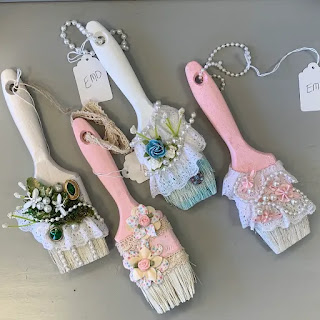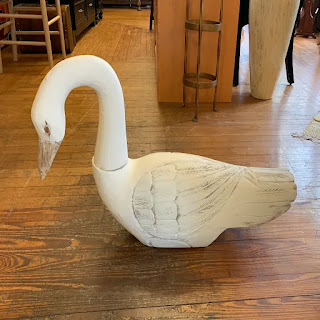Have you ever wondered if renting a booth at an antique mall is worth it? I did for years, until my mom and I finally bit the bullet and did it.
What I'm going to share is our own experience. Things may be totally different for other antique booth vendors, which will be different for you too. But here's a good starting point.
First, where do you live?
 |
| It sometimes gets even better than a yard sale here. This is where I found my 1940's wooden ironing board just waiting for the trash. Click HERE to read the whole story! Even the cookbook are good to resell. Free means 100% profit! |
often downsize and they have the most amazing yard sales. And the stories I hear when I buy some of the stuff take me back decades and warm my heart. "My mother made cakes with this old bundt pan..." and "those teacups were a wedding gift for my grandparents," are just a couple of lines I've collected, along with their treasures.
In addition to yard sales, and the occasional street find, we have a plethora of thrift stores to choose from in our area. Again, these are great places to pick up those vintage items from the downsizing crowd.
One interesting fact is that a thrift store that one vendor loves, another would never go to. Most of the vendors that are in our store shop only at one or two places. One woman swears by the "bins" at Goodwill. We can't stand them! Another goes to a more upscale consignment shop a few towns over. She gets really nice finds, pays a little more for them then sells them for a little more too.
When you're just starting out, give many places a try; even multiple tries. We usually shop at a Salvation Army that's just a mile from my house. We go on Monday, when the "bric-a-brac" is half price. Getting stuff half off really helps our bottom line, but it's not always the best thing. We now go in 2-3 times a week and always come out with something great to resell.
Some vendors shop every single day. At first I couldn't understand this, but after thrifting for a while, I came to realize why. Some things don't even get from the cart to the shelf before someone snatches them. Things like vintage, collectable Pyrex are usually gone instantly.
So before you begin, consider if you have a good base for buying things, especially if you want to make some money at it. For example, if you live in a very rural area, good deals may be more scarce. Gas, especially right now, needs to be considered too. If you spend $75.00 a week running around only to clear $300.00 a month, you’ll be at a break even point at best.
Are antiques a good business in your area?
I think every place needs at least one antique store. But they seem more at home in some locations than in others. In my hometown of St. Petersburg, we do have a fair amount of antique stores, but shoppers here, especially tourists, can often want something different. Our city vibes can be a little on the beachy side. Many stores sell a lot of turquoise painted furniture, mermaid wall hangings and shell decor. We've tried to incorporate some of that in our booth and it just doesn't sell for us. But it's still some of our competition.
Because there are always some people who want true vintage and antique items in any area, we do fairly well. But do consider the type of people who live in your area. It may be easier to sell antiques in Pennsylvania than Florida, so consider who your customers are and what they may like.
Also, it seems that areas that attract tourists often have quite a few antique stores. And that can be both good and bad. Good because it may be known by shoppers as a great antique area and that brings in a lot of sales. But it could also be that the market is saturated there and it can be hard to make your rent. Sometimes there aren't easy answers in this business.
Trying is often the only way of finding out.
What do you love?
 |
| This Windsor Settee is my aesthetic. It was handmade in New England, given to the Salvation Army and sold (to me) for just under $100.00. I can't bear to part with it. |
But first, let's define vintage. Some say anything over 20 years old is vintage. A stricter definition would be anything that's between 50-99 years old is vintage. Over 99 years and you've got a true antique.
But having said that, there are so many different kinds of vintage items. I love things that are rusty, dented and "well loved". Old willow baskets are my first love. I also appreciate mid-century things such as Pyrex, aprons, clocks, etc. My mom, and business partner, doesn't like that at all. She prefers things that shine; crystal bowls, polished brass candlesticks and fine china are her style.
Buying things you love is a part of being a vintage vendor. You have to believe in and love the items you peddle. But you also have to be willing to change course, at least a little, to boost your sales.
It's certainly acceptable to have a variety of items in your booth, especially if you're just starting out. You have to get a feel for what sells. Then you may want to start specializing in things that you see sell well for you. Our specialty is "things that are useful." That may sound like a lot of things, but for us, we narrow it down to things like kitchenware, baskets, magazine racks, bookends, etc. Figurines and "tchotchkes" that just sit there don't sell as well for us.
That's not to say that we only have those items in our booth. When shopping at thrift stores, we take what we feel we can make a buck on. That leads us to have a wide variety of items. But typically, we sell useful items.
 |
| A very clever person combined vintage paint brushes with flowers and pearls for a really cute thing to sell. |
Your booth should be a combination of stuff you love, and stuff your customers want. And keep in mind it can take a year or so to really hone in on what you love and what sells. But don't be deterred by that. That's normal.
We have typically sold almost everything we've ever bought. The tipping point is how long the merchandise has to sit there before it leaves the store. If it takes up 1 square foot and takes a year to sell, that's bad real estate. Turning stock over quickly is the best way to make money, even if you have to ask a little less for it.
You can also get a "following." I didn't even know that happened to us except that the shop owner at the time told us that this happened shortly after we moved in. We were thrilled. People with the same tastes as you will look forward to coming in your booth and seeing what you have each time they visit.
Waiting lists are normal and can be long.
I suppose the need for vendors at antique malls fluctuates just like any market. Right now real estate values are skyrocketing in our area, forcing some antique markets to close. Those vendors are frantically looking for new places to sell, and it's difficult to find a booth. Waiting lists in some malls are up to 2 years long.
But that may not be the case in your area, and this area could change too.
The process can sometimes be difficult.
The owner of our antique store just sold the place last year, so we thought we were going to need a booth in another store. The place we applied at won a "Best In The Area" and is very well known. Applying there was like a job interview. We had to write a letter introducing ourselves, stating our experience and send in pictures of some of the items that we were going to carry.
We jumped through all the hoops successfully. It helped that we had several years experience and a full booth ready to move. Yet we never heard back from them and it's been over a year. Luckily, we were able to stay where we are, so we really didn't need the space, but if we were just starting out we'd be waiting a really long time.
This happened to us at another antique mall a year earlier when we were trying to expand. We put our name on a waiting list. We frequented the shop often and reminded them that we were still interested. We never heard from them-ever.
If you're desperate to get your foot in the door, take whatever they have at first. It will usually be something small, maybe in the back. But this will allow you to move up quickly when a more desirable spot becomes available.
But don't let this discourage you. Keep trying. Work your way up by taking a smaller space at first. Keep reaching out to let them know that you're still interested. And be patient!
Selling things other than vintage.
 |
| My cards for sale at our booth. |
When people are out shopping at antique malls, they're likely to pick up other things as well. Shopping is shopping! So consider if there's something else that you may enjoy making too.
Some antique stores allow for this, others don't. Just because you don't see anything but vintage items, don't assume they don't want your merchandise. Ask! They may welcome something different in their stores.
 |
| I spotted these adorable stuffed figures at an antique store in Dahlonega, Georgia. |
Consider Pop Up Markets
Pop up vintage markets have become somewhat of a thing around town here. This is where a vintage market happens every once in a while, or sometimes just once or twice a. yar. Vintage Marché is the largest and most frequent in our area. It happens once a month.
Most of these will be juried, but if you've already got a lot of things that you'd like to try to sell and don't want to make a commitment to a booth, this could be a good alternative for you.
The down side to these is that you have to drag all your stock in and out for just a couple of days of sales. However they are very well attended and the schlepping should pay off.
Consider sharing a booth.
Several vendors I know share space and rent in one booth. This allows for you to have a bigger and sometimes more prominent booth while not making a commitment of several hundred dollars a month.
You'd have to get this approved from the shop owner, but they're usually willing to accommodate such requests.
Move Stuff Around!
Once you get your booth, be sure to mix up the merchandise on a fairly regular basis. This really helps us sell in our booth. Often antique stores have regular customers, so you'll need to keep their attention, and if your booth always looks the same they may just quickly walk on to the next room.
You don't necessarily have to move large pieces of furniture around, but shifting the smalls (as their called in the business) can make them stand out more.
Have "smalls" and large items.
 |
| Here's a "large" that's not really too big. It's my $5.99 stained glass-like medallion. If we can get $65.00 for it, it will qualify as a large item. |
My mom doesn't always agree. She says that we need big things to help pay the rent too. And she's right. If we can sell at least one $50.00 item, it goes a long way to making our monthly rent.
And keep in mind that "larges" don't necessarily have to be large. Usually they are, but not always. Below is a piece that I paid $5.99 for at the Salvation Army and we're marking it around $65.00.
So as you shop, look for things that will bring in bigger bucks, regardless of the size. But don't have only large items. I think that if you only have furniture for example, you're missing out on what most of the population buys. There is one vendor in our store who is leaving this month because that's all she has, and she's never sold one item since she's been there.
Furniture may sell well in some areas, but here we tend to have little houses.
Do we make money?
Yes! A lot? Not exactly. At least not every month. For many of us vendors, the first line of success is about "making your rent." You'll hear that term a lot. If your rent is $100.00 a month, you'll want to make at least that, of course. Typically it's ideal to triple your monthly rent in sales. It took us a few years before we were doing that consistently. Like I mentioned earlier, we needed to get a feel for who we are and for what our customers want.
Currently it's not unusual for us to make 4 times our rent, which we are really pleased with. But it did take some time to get to that point.
But it's not all about the rent, unless you're liquidating things that you currently have in your home, you'll have to account for the price that you paid for the item, plus any commision you pay the store.
How much do we pay?
We have a really good deal. Our booth is about 9' x 9' and we pay $160.00 a month. That's around $2.00 a foot. Plus we pay them 15% of everything that sells. Other areas may command much more however. And other areas less. Ask around at a couple different stores if you feel you're not getting a good deal.
That's a really good rate for our area. Some antique stores and malls charge more per square foot and extra for advertising, etc. too.
Do "sales" work?
Sometimes, like at Christmas, our whole store offers 20% off. At Easter they had "pick an egg" and get a certain percentage off. We are always allowed to have sales for individual items, plus sales off the entire booth.
We sometimes do this in the slow months. For us, those months are June, July and August. (It's in the mid 90's here and even the locals stay inside.) But usually we don't offer sales.
They may boost sales, but just a little. Plus we find that we mark new things a little higher if we know a sale is coming up. We try to price your things fairly and reasonably, so that even without a sale, people will want to buy. Vintage shoppers know that if they see something they like they need to pick it up or else it may not be there the next day.
Jump in and try!
One nice thing is that many stores don't require you to sign a lease. If you can get a place like that, give it a try. Although keep in mind that it may takes several months to get the ball rolling.
Also, starting small can be good too. It takes a lot of product to stock a large, say 10' x 10,' booth. We take two laundry baskets of items to fill in our booth, and often it doesn't even look like we added anything. The booth seems to absorb a lot of merchandise. So the smaller the space the more you'll be able to keep it well stocked, especially in the beginning.
A few more tips:
• It's not proper to ask other vendors where they get their stuff. It can be perceived as trying to hone in on their turf. (Even though deep down I'm dying to know!)
• Make sure you remove all the thrift store stickers from your items before you put them in your booth. I can't tell you how many times we've messed this up. It's so embarrassing to tag something for $22.00 and the customer finds a $3.00 sticker on the bottom of the item. The Salvation Army sometimes places 2 or 3 price tags on certain items, so make sure you get them all off!
• Lastly, check eBay and Etsy before pricing things. You may be surprised how much things go for. Another service, Worthpoint.com is a good investment if you're selling a lot of higher priced things.
No Matter What, It's Fun!
At one yard sale, a girl told me that she was selling her stuff because she has enjoyed it for a little, now it was time for someone else to enjoy it and for her to get more.
Perhaps that's the motto of many of us antique booth vendors. We enjoy the thrill of the hunt; love possessing the item for a while; then passing it on to someone else who will love it.
Let me know if you take any of my advice and how it works out for you. And I'd love to hear from those of you who are currently vendors too. Am I on point? Have you had similar experiences? It would be a blessing to hear from you!
















